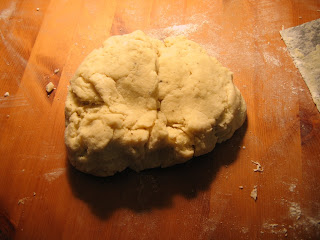(Rejected suggestions for post title: "Gnocchi Dokey," "Gnocchi Country for Old Men, " and "Point of Gnocchi Return.")
I love gnocchi. For lunch, for dinner, for breakfast - doesn't matter. In fact, if a survey was administered, and four out of five dentists preferred gnocchi to other Italian foods, I would pummel that fifth dentist until he acquiesced to gnocchi's inherent goodness. (Or, maybe I'd just feed him more gnocchi. That "pummel" thing is pretty violent.)
For those unfamiliar with gnocchi, they're little pillows of potatoes and magic, held together with flour and egg, and ever-so-slightly flavored with salt and pepper. While their vitamins and minerals are somewhat lacking, they're virtually fat-free, and a nifty twist on plain ol' pasta. Even better, gnocchi is inexpensive and can be paired with just about any sauce on earth, except maybe those of the barbecue variety. (Which, on second thought, might not actually be so bad.)
Before last year, I tried making gnocchi a few times on my own, and they came out okay. A little gummy maybe, but edible. (Gumminess, by the way, is brought on by too much moisture and is the mortal enemy of gnocchi.) Then, in March 2007, I took a gnocchi class at a local cooking school, and - oooooo. My gnocchi are much better now, due in large part to Chef Gerri, who taught us to roast the potatoes instead of boil them. It reduces the amount of moisture to which the potato is exposed, giving the gnocchi a better chance of surviving the tumultuous boiling process.
The dumplings improved even more when I caught a gnocchi-centric episode of Lidia's Italy. In her awesomely competent way, Ms. Bastianich demonstrated another ace method of reducing moisture: after the hot potatoes were put through her food mill, she spread the results out as much as possible. That way, the steam escaped and the possibility of gnocchi-destroying gumminess was severely reduced.
With that in mind, attached below is my recipe for gnocchi, replete with poorly-lit step-by-step photos. You might notice I skip the beautifying forkmark process. This is for two reasons:
A) I'm lazy. There are almost 200 of those suckers.
B) I'm really, really bad at it. Like, almost as bad as I am at driving, which is pretty bad.
I plan on trying butternut squash and/or spinach gnocchi at some point, so look for that in the future. (The NEAR future, I'm not sure.) In the meantime, enjoy.
Potato Gnocchi
Makes about 150 gnocchi, which serves 4 generously and 5 very well
2 ½ lbs starchy white potatoes (Russets)
2 cups flour
1 large egg
salt and pepper
1) Preheat oven to 400F.
2) Scrub and dry potatoes, then pierce each one several times with a fork. Place them on a cookie sheet and roast until tender/easily pierced through with a knife. (Probably 45 minutes to an hour.) Remove from oven.
 3) While potatoes cool slightly, bring a large pot of salted water to a boil.
3) While potatoes cool slightly, bring a large pot of salted water to a boil.4) Once potatoes are cool enough to handle (but still hot/very warm), peel the skins off with your hands. The earlier this happens, the better. A pair of rubber gloves (or sandwich bags slung over your hands) should help you handle the spuds.
 5) When the potatoes are peeled, put each one through a ricer or food mill (medium grate). Make sure you spread the riced potatoes out as much as possible, as this will help moisture evaporate.
5) When the potatoes are peeled, put each one through a ricer or food mill (medium grate). Make sure you spread the riced potatoes out as much as possible, as this will help moisture evaporate. 6) Once the tubers have cooled, place them on a clean, dry surface. Then, sprinkle salt, pepper, and 1-1/2 cups of flour over the top.
6) Once the tubers have cooled, place them on a clean, dry surface. Then, sprinkle salt, pepper, and 1-1/2 cups of flour over the top. 7) Form the potatoes and flour into a small mound with a well dug out in the center.
7) Form the potatoes and flour into a small mound with a well dug out in the center.8) Whisk the egg in a bowl and pour it into the well.
 9) Using either a pastry scraper or your bare hands, gently knead the entire mound together into a big ol' ball. This shouldn't take longer than ten minutes, but will probably take far less. If the dough still feels sticky or tacky as you go along, add more flour.
9) Using either a pastry scraper or your bare hands, gently knead the entire mound together into a big ol' ball. This shouldn't take longer than ten minutes, but will probably take far less. If the dough still feels sticky or tacky as you go along, add more flour. 10) Once you have your dough ball, break off about an eighth of it. Using your hands, carefully roll this piece into a long, thin log, about 1/2 - 3/4 inch in diameter.
10) Once you have your dough ball, break off about an eighth of it. Using your hands, carefully roll this piece into a long, thin log, about 1/2 - 3/4 inch in diameter. 11) This is the most important part: using a knife or a pastry scraper, cut off a 3/4-inch piece (not the end piece) of the roll. It should look like a tiny pillow. Drop the piece into your pot of boiling water. When it rises to the top, it's finished.
11) This is the most important part: using a knife or a pastry scraper, cut off a 3/4-inch piece (not the end piece) of the roll. It should look like a tiny pillow. Drop the piece into your pot of boiling water. When it rises to the top, it's finished.12) Eat the piece. If you like it, go ahead to step 13. If it's gummy or falls apart in the water, that means there's too much moisture in the dough. Add more flour (1/8 - 1/4 cup) to your dough ball, knead it in, and try again until you get the result you desire.
 13) Chunk by chunk, roll the remaining dough into logs. After each log is made, cut them into 3/4-inch pieces. Each piece should be about the size of the top of your index finger, from knuckle to nail.
13) Chunk by chunk, roll the remaining dough into logs. After each log is made, cut them into 3/4-inch pieces. Each piece should be about the size of the top of your index finger, from knuckle to nail.
 14) Place each piece of gnocchi on a cookie sheet lined with wax paper. This will give you an idea of their numbers AND set them up for freezing later.
14) Place each piece of gnocchi on a cookie sheet lined with wax paper. This will give you an idea of their numbers AND set them up for freezing later. 15) Drop a full serving (between 20 and 30 gnocchi) into the pot of boiling water. When the gnocchi rise to the surface, remove them with a slotted spoon (or other hole-y implement) and place them into a serving bowl. This should take between 3 and 5 minutes per serving. You may have to drain extra liquid from each bowl at the end.
15) Drop a full serving (between 20 and 30 gnocchi) into the pot of boiling water. When the gnocchi rise to the surface, remove them with a slotted spoon (or other hole-y implement) and place them into a serving bowl. This should take between 3 and 5 minutes per serving. You may have to drain extra liquid from each bowl at the end.
 16) Add sauce, parmesan and dig in.
16) Add sauce, parmesan and dig in. NOTE: To preserve uncooked gnocchi, simply chill the pan from step #14 in your freezer. When gnocchi is frozen through, dump 'em in a plastic bag, squeeze the air out, and seal. Voila.
NOTE: To preserve uncooked gnocchi, simply chill the pan from step #14 in your freezer. When gnocchi is frozen through, dump 'em in a plastic bag, squeeze the air out, and seal. Voila.Approximate Calories, Fat and Price per Serving
387 calories, 1.7 g fat, $0.53
Calculations:
2 ½ lbs starchy white potatoes (reduced to 2 ¼ after peeling): 950 calories, 1 g fat, $2.37
2 cups flour: 910 calories, 2.5 g fat, $0.10
1 large egg: 74 calories, 5 g fat, $0.15
salt and pepper: negligible calories and fat, $0.04
TOTAL: 1934 calories, 8.5 g fat, $2.66
PER SERVING (TOTAL/5): 387 calories, 1.7 g fat, $0.53





 7:18 AM
7:18 AM
 ari sari
ari sari

 Posted in:
Posted in: 























